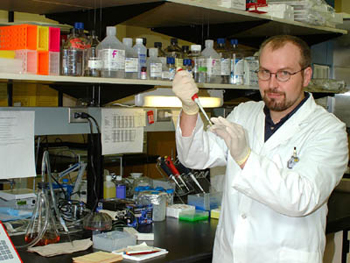 |
Kay-Uwe Wagner, Ph.D. |
Now, through a UNeMed licensing agreement, the model is assisting labs around the world and generating income to advance Dr. Wagner’s own study of genes that play a role in the development of cancer.
“It is a pleasure to develop tools and models that are being used in academia and now, also, in industry,” said Dr. Wagner, associate professor in the Eppley Institute, since 2000.
Dr. Wagner and others will be recognized for their licensed technologies and issued patents at UNeMed’s 2007 Innovation Awards on Aug. 23. The campus is invited to the 4 p.m. ceremony in the Durham Research Center Auditorium. A reception will follow in the DRC Atrium.
“The Jak2 license shows that we don’t always need to have an issued patent to generate license income,” said Michael Dixon, Ph.D., director of intellectual property for UNeMed Corporation, the marketing and licensing arm for UNMC.
“Our researchers spend a considerable amount of time and energy creating unique research tools to answer important questions,” Dr. Dixon said. “These research tools have significant value to industry — often they would rather buy the tool than spend the time it would take to create it themselves.”
Through a research tools license with a large biotech company, Dr. Wagner’s Jak2 mouse model will allow researchers worldwide to study hormone and cytokine action in adult mice.
“The model is important to study the function of hormones not only during normal development, but also in various cancers including breast cancer and leukemia,” said Dr. Wagner, who was among UNMC’s 2006 Distinguished Scientists. “Recently, mutations in Jak2 have been reported to be crucial in various myeloproliferative disorders. Essentially, we can turn off the function of the Janus kinase 2 (Jak2) gene in any given cell of the body at any given time.”
Dr. Wagner’s former postdoctoral fellow, Andrea Krempler, developed the DNA construct to modify the Jak2 gene. It then took about four years to characterize the complex mouse model, Dr. Wagner said, noting a significant portion of the revenue generated from the licensing of the mouse model was reinvested in his lab for additional research and development.
“The Jak2 gene is quite interesting and has been implicated in cancer as well as aging, so it seems likely that this model will find an even wider audience,” said Tom Rosenquist, Ph.D., vice chancellor for research at UNMC. “Dr. Wagner is a great example of a productive basic scientist who has had the wisdom and foresight to protect the intellectual property coming out of his work, and by doing so, to benefit from it. It is a major goal of UNeMED to mine the expertise of all of our outstanding UNMC scientists, and facilitate the process of intellectual property development to the mutual benefit of the scientists and the university.”
UNeMed assists with all material transfer agreements with both academia and industries, Dr. Wagner said, noting there are several requests from investigators around the globe each month.
“UNeMed does a great job processing these contracts in a very short time, so no investigator has to wait a long time to receive the requested materials,” he said. “It is usually the intellectual property office (IPO) of the receiving institute that is working more slowly.”
Material transfer agreements help protect a researcher’s property rights, as well as ensure that the source of the materials is properly cited in any resulting publication, in which the materials are used. “Once materials are in the public domain, many researchers pay little attention to acknowledge the original source of the reagents,” said Dr. Wagner, whose mouse models are being distributed by the Jackson Laboratory and the National Cancer Institute Mouse Models for Human Cancer Consortium Repository in Maryland.
Over the past year, the UNeMed office has received increasing numbers of request for information regarding research tools developed at the medical center, said Steven Schreiner, Ph.D., senior licensing associate for UNeMed.
These tools, which allow for the advancement of research and the development of therapeutics and diagnostics, can take many forms, including antibodies, animal models and cell lines, he said. “The licensing of Dr. Wagner’s Jak2 mouse model exemplifies the value of the developmental work being performed by the research community at UNMC,” Dr. Schreiner said. “It shows that industry is taking a closer look at what the medical center has to offer them in the form of materials and scientific expertise.”
Dr. Dixon praised Dr. Wagner for his innovative work, as well as for recognizing the extensive value of his research tool to others. “I encourage the rest of the UNMC campus to continually be aware of the research tools they create and bring them to UNeMed’s attention so they can be made available to industry,” Dr. Dixon said.